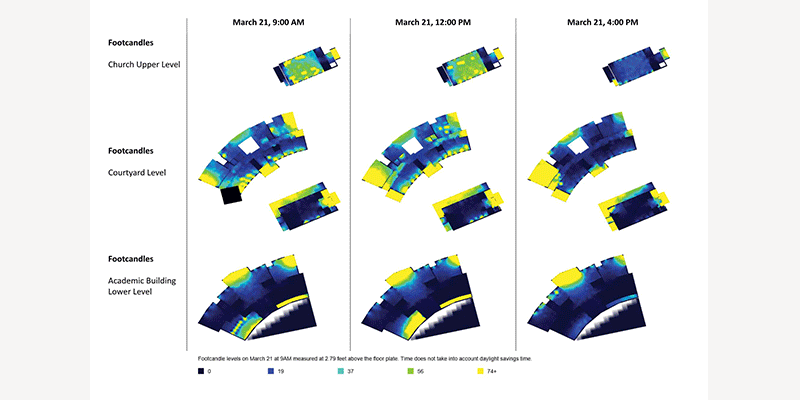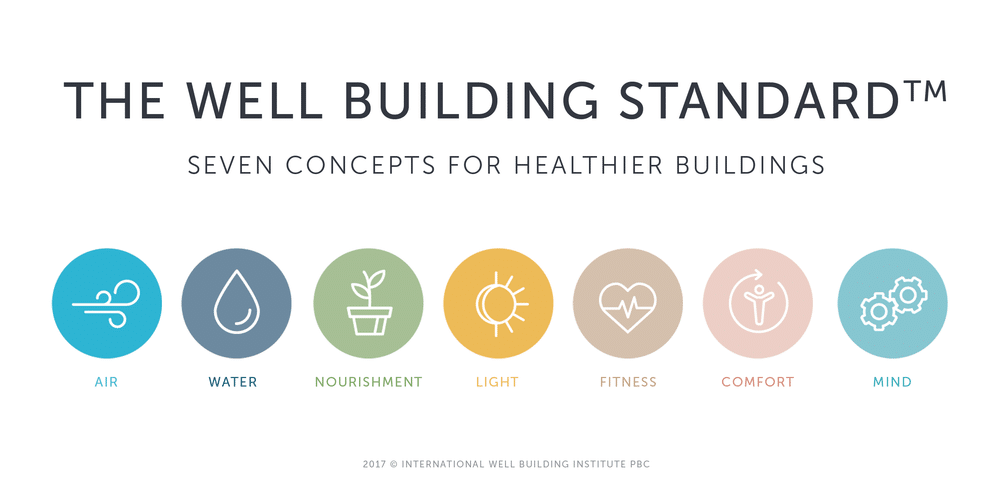The term “daylighting” refers to architectural design that allows natural light into buildings. Daylighting provides many benefits, including increased productivity, enhanced connection to the outdoors, improved health, and energy savings. As a result, it’s highly desirable in educational settings.
Numerous certifications for high-performance buildings feature daylighting as part of their rubrics. They cite daylighting as fundamentally important to sustainable design by connecting occupants with the outdoors and reducing the need for electrical lighting, thereby improving occupant health, creating energy savings, and offering higher-quality light. (See a list of some of these certifications below.)
Effective incorporation of daylighting into a building’s design strategy requires early and thorough attention. It involves a combination of advanced technical skills and mastery of traditional design and construction principles.
Incorporating Daylighting at Slate Upper School
As a follow-on to a successful project we completed for Slate School, we are currently designing a new facility for Slate Upper School. It will offer project-based education to students in grades 7-12. The project includes the reuse of an existing church building as a performing arts space, and a new academic building buried in the site’s topography. The design emphasizes the school’s natural context (including amazing views of nearby Sleeping Giant State Park), flexible and healthy learning spaces, and sustainability. We have introduced daylighting strategies as a major component to the design.
Natural Light Where It’s Needed. Darkness Where It’s Not.
There are a number of fundamental building strategies that pertain to daylighting. These include building orientation, building organization, and the recognition that different types of spaces need different qualities (and amounts) of light.
Working within the site’s natural hillside topography, the new academic building is oriented with a broad side facing south to maximize sun exposure to the spaces along that side. Rooms with programs that don’t necessarily need a lot of light (“dark” learning labs and flexible classrooms) will be “buried” in the topography—meaning they will be located at the back of the lower level.
Classrooms and “living rooms” that will benefit from natural light and great views are located along exterior walls where daylight is plentiful.
Simulating Sunlight to Inform Our Design
In creating our design for Slate Upper School, we are using daylight simulation software to determine how different building orientations and space organization will affect the amount of natural light a space receives. Specifically, we use a software called Sefaira to analyze our digital building model.
These simulations include average quantities of daylight delivered to rooms over the course of a year, and specific quantities on a particular day and time. The software also helps us identify overlit and underlit spaces. We can then increase or adjust the windows in rooms shown to have lower levels of daylight, and decrease windows or install shading devices in rooms that are overlit.
Of particular interest are the design’s central, two-story atrium and hallways, which we want evenly daylit but that are at the center of the building. We have used the software to experiment with various strategies for toplighting these spaces, including large, translucent “Kalwall” skylights, clerestory windows, and “Solatube” light collectors.
We have even experimented with various roof shapes to understand how differently sloped roofs might reflect daylight down into spaces. We performed similarly focused explorations for the upper floor performance venue in the existing church building, refining a new roof with clerestory windows to provide even and abundant light in the performance space below.
Daylighting and High-Performance Buildings
Effective use of daylighting, and a connection to nature in general, are key components in many certifications for high performance buildings. Here are a few of these certifications, with highlighted credits or principles related to daylighting:
Northeast Collaborative for High Performance Schools
- EQ 11.0 Daylighting: Glare Protection
- 1 Daylight Availability
- EQ 12.0 Views
- EQ 12.1 Additional Views
LEED (Leadership in Energy and Environmental Design) for Building Design and Construction
- EQ (Indoor Environmental Quality) Credit: Daylight
- EQ Credit: Quality Views
WELL Standard (under the Light concept)
- 62: Daylighting modeling
- 63: Daylighting fenestration
Living Building Challenge
- Imperative 09: Biophilic Environment: How the project will be transformed by deliberately incorporating nature through Environmental Features, Light and Space, and Natural Spaces and Forms.
Shedding Light on Effective Designs
In addition to the technical skill required, two attributes that architects and building owners need to have in order to ensure that spaces get just the right amount of natural light are curiosity and a willingness to iterate through a series of daylighting studies.
We have worked with the client to test different fenestration strategies and balance daylighting performance with design. In the end, our design will create efficiently lit, healthy interior spaces that are conducive to learning.
Could your new construction or renovation project benefit from more natural light, and can the right design supply it? The best way to find out is to talk with us. Please contact us at your convenience.





